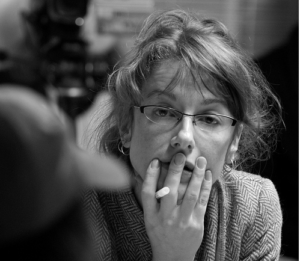
Out of Bounds: an interview with Althea Thauberger (2008)
Mike: Well, here we are in Skypeland. You grew up as a Jehovah’s Witness, an evangelical faith that feels the touch of the world’s end in present events, and refuses state anthems or military service. It is a rigorous and exclusionary grouping, seeking converts via door to door visits. Can you talk about your time inside the fold, and why you’ve likened these experiences to the sometimes isolationist art world horizons that have become your new home?
Althea: When I was growing up, there were times that I was active in the religion, and going to meetings and door to door and so on, and times when I wasn’t. After I left religion at seventeen, I felt ashamed for a long time. I started to think, I started to read. I knew a lot about the bible and doctrine and the church but I didn’t know much about anything else and I had not been exposed to the experiences and ideas that many of my new friends had. I felt ashamed about that. After a period of time I started to let go of that shame, and started to be able to speak about it with others.
I am not sure what all to say. I have certainly been hugely influenced by the experience of viewing the world though a rigid ideology and a slanted kind of apocalyptic lens. When I was in San Diego in 2004-2005 I spent time in a military housing complex that was geographically isolated. These housing developments are placed on hills with freeways running in the valleys between them. I was going to community events, dinners organized by the United Service Organization that would be prepared and paid for by a different community group every week so military families that were struggling could go and talk and have a free meal. I volunteered for after-school programs with new mothers and women’s craft circles in order to understand what kinds of organizations were out there and what they did. It reminded me of the kinds of groups that form in religious communities who maintain social cohesion amongst members that don’t have a lot of contact with the outside. These community workshops and meetings serve as a soft surveillance so that what might be perceived as deviance or doubt can be noticed right away and dealt with. That’s the case in the military, necessarily so, because when you have family in the US and a partner deployed abroad, the partner can’t be thinking that things are not going well within the family because then everything starts to fall apart. It reminded me of the social control I was raised in, and that gave me a lot of insight and empathy for what the women were going through.
Mike: Does the art world function the same way? Is it also a small place contained and managed via mutual surveillance?
Althea: In a way, though there are many art worlds. When I speak about it in the singular it’s not really correct, but it’s more convenient. It’s a pretty small contained place where we seek and need approval and recognition, in a kind of ideological way, from an establishment whose vision is kind of narrow. There are pros and cons to this narrowness of course. As we know there are certain rewards provided by the art world, and generally those rewards are made available to artists who are able to perpetuate systems of meanings that we can quickly recognize and that make us feel smart and competent and in the know. It usually rewards art that is just a tiny bit transgressive, and in the right ways. Just enough to evoke a patina of criticality and self referentiality, and cleverness. We could speak about the market, public and private institutions, the systems and imperatives that underlie the business of this kind of production.
I have looked up to Ken Lum’s work for a long time for its position in all of this. Two younger artists working now who I admire a lot are Skeena Reese and Duane Linklater. I see their work blasting open space that hasn’t been open before, especially in Canada, and it’s often uncomfortable, and it resists in some of the most fundamental and destructive assumptions in the production of art-meaning. In certain instances the work is only allowed to go so far and when it goes out of bounds it’s not allowed to be successful anymore, it isn’t supported. It’s not as easy to show it or talk about it. But those out of bound places are where we must go, with some care of course.
What does it mean to be out of bounds? I guess it means not being observant of the accepted vocabulary and frameworks and formulas that we’re supposed to operate in, and that are coherent enough where the dots can be well described and well connected. Maybe being in bounds just enough to destabilize boundaries. For example, in Skeena’s performances, she achieves a profound uncertainty about where her audiences are being led and how they are to participate, and an anxiety that arises through political correctness. The codes of the art world are a bit suspended though still tug at us. We are compelled to follow her, and are seen negotiating these anxieties. This is really productive. In my own work, some have difficulty when I work with subjects we’re supposed to be unilaterally critical of, like military subjects for example, but without an obvious distance provided to the viewer though which to experience criticality in a comfortable way, or without identification with them. A particular narrow notion of criticality is in my view part of the deep structure that we’re supposed to have in common as art audiences, and that comes out of certain ideas of social positioning.
Mike: By “criticality” you mean that as viewers we’re supposed to maintain the safe distance of a spectator, forever in judgment, never carried away.
Althea: Yes, contemporary practice requires a particular ideology, a kind of codified distance that is recognized and allows a comfortable digestion. The code details the kind of experiences or emotions we’re supposed to be resistant towards. I guess I’m talking a lot about codes.
Mike: So it disrupts the “us?”
Althea: By us I mean the readers, the sense makers, the people who are involved in the apparatuses of art on every level and also those who are supposedly excluded or not valued in relation to these apparatuses. And I’m not talking here so much about work that has an obvious value and consensus in other spheres. For example, there is a lot of important projects that are being produced in social justice practices and in community art practices that are contexualized in contemporary art, and this is important, and this work often has tangible results in terms of influencing policy, or empowering people and so forth, but that’s not what I am talking about. What I am talking about is work that creates a profound uncertainty about what it is, how it is functioning, what are its parameters, and what is at stake. It is tricky because that work has got to be really compelling, and rooted, or actively implicated in the social conditions of its production. I knew you were going to ask for examples. Khaled Hourani’s work Picasso in Palestine might be an example of this. Or Theaster Gates’ work, or Jens Haaning’s, or Skeena’s work that I have already mentioned.

Mike: In Carrall Street (2008) you closed down a downtown block for three hours, set up floodlights at either end, and then let loose a coterie of performers. It’s an uneasy neighbourhood where the old tourist haven of the city meets up with the Downtown Eastside, also known as the poorest postal code in the country. It was a typically bold and controversial gesture on your part. Can you talk about the responses?
Althea: Carrall Street brought together people who came from community art backgrounds, contemporary theatre backgrounds, all kinds of artists including street artists, and then multiple publics. There were also different kinds of activists: direct action and others working on housing advocacy within the system for example. There were a lot of perspectives from which to critique the project! (laughs) But also a lot of perspectives to appreciate it from.
Let’s start with art audiences. First of all, people were annoyed because when they arrived they felt nothing in particular was happening. They were expecting some kind of show, rather than being placed in the middle of a stage and being observed. Ultimately everyone who came was a participant including myself. You’re standing on a lit street and everyone is looking at you wondering if you’re a performer, which in fact you were. I don’t know if you’ve been to that block on Carrall Street recently, but generally when art people go there it’s for an opening at Artspeak or Access (gallery) which used to be across the road. Openings would spill out on the street with gallery people standing in small groups. Frankly, for most of the Carrall Street project, that positioning didn’t change much. Art audiences were talking to each other in little circles and glancing over their shoulders, a bit apprehensive or reluctant or annoyed. I noticed that of course, but I wasn’t actually on the street most of that evening, we had rented space a few buildings away which was a kind of green room for the performers to come and go from. I was mostly there assisting the performers.
The actions ranged in terms of whether they were recognizable as a performance or not. Skeena Reece did a performance in a nurse’s costume that makes people uncomfortable but also is really witty. She interviews people and then administers decolonization shots with a large needle. Archer (Pechawis) was there in a suit as a real estate marketer, he actually replaced a real estate sign on the street and handed out cards. There was a group of experimental dancers, some of them were quote unquote Downtown Eastside artists, and some were recent graduates from Simon Fraser University’s experimental dance program. They were quite visible as performers. Small groups of young actors improvised loosely scripted dialogues around situations they imagined related to how we saw young people use this street. When they became louder some people recognized them as performers and some didn’t.
There were more intricate scripts where people were engaged one on one. Kim Collier and Jonathan Young were running The Electric Company at the time. Jonathan had written quite a beautiful script and Kim was enacting it. They had a collaborator who chose a random person and asked them to come for a drink. In the bar, The Irish Heather, they were handed a drink, a cell phone and a script. They were asked to play their part with the person on the other end (Kim on the street). The script was a story about the street that moved back and forth in time, and at a certain point the lines of the participant disappeared, and they had to improvise. After awhile they were asked to come out and look for a woman in a green coat and give the cell phone to them (Kim again). If you weren’t one of the people who participated in that dialogue you wouldn’t know it was happening. I could give you more examples like that.
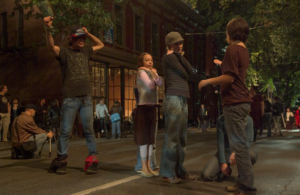
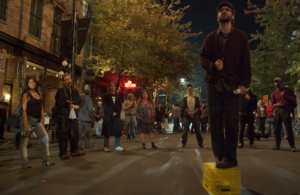
What else did art people say? There was disappointment about the “lack of focus” of what was happening. If you came for ten minutes you might see a few actors and think that was it. Over the course of the evening the mood changed along with the number of performers. There were a couple of speeches that were perceived as a climax but actions followed that weren’t focal points. There was criticism that some interacted with people they didn’t know were actors and then felt foolish about it afterwards. That was surprising to me, I thought, why is that something you would feel foolish about? And finally, in the written responses that followed the work, there was a lot of questioning about why it was necessary to theatricalize a street or location that was already quite theatrical. (It’s a place where a lot of stuff goes down and people perform themselves, and street people and other residents and business people have created public personas.) I did not see my work as re-theatricalizing anything per se, but providing a kind of particular focus and particular stakes. “Why focus on a neighbourhood that they saw as being over-represented in the art world?” was something I obviously didn’t agree with. .
One article questioned the project’s press release, and we were accused of false advertising. It was described, I believe as an “experimental street performance,” and I was told people were expecting a performance as a singular focal point. While I had commissioned many performers, I didn’t know what they were going to do. So much of what was enacted that night was a surprise for me too. Another really important part of the critique was the budget of $58,000. Everyone knew the figure because we got a public and published grant from funds that had been set aside for community projects in the three years leading up to the Olympics. A small portion of this fund, a negligible portion actually, came from the Vancouver Organizing Committee for the Olympics, and because of the political climate in the city, a lot of people were boycotting anything that had Olympic funding. I also thought that in that moment it was important to be hyper aware of how the Olympics were branding culture in the city, but this fund was somewhat different because the vast majority of the money was coming from the Canada Council, the city of Vancouver, the Vancouver Foundation, the Audain Foundation, the British Columbia Arts Council. Nevertheless, it was a fund whose project was to create a climate of anticipation in the city leading up to the Olympics which is clearly fraught.
I was really interested in the fact that the budget was fully on display, open to scrutiny, and in a way part of the subject matter. This is how much it costs to close down a street, to pay forty performers and hire out a cinema lighting crew. But of course people were saying that this was a huge budget, and to spend that kind of money on one evening event in that neighbourhood was gross. It should have some kind of legacy or involved more street performers, or it should have been a carnival where people could sell work, or it should have had some kind of educational component. The sometimes pat, but ultimately really important positions that normally get brought out when public funds are attached to an impoverished place were voiced. If my goal was to make something visible I should have shone lights on John Furlong’s lawn, for example. He was the head of the Organizing Committee for the Olympics. Well, I thought, that’s not even remotely what the work is about, it’s about what’s happening here, in this particular place. The history of us being here. We are here at the same moment, paying attention to the relations and visibilities and memories and beauty and fictions and realities and interests and architectures and implications and brutalities of the various “us-es” in this place, at this crucial moment, when this place is on the very brink of massive change.
There were also a lot of positive responses, many from community people or activist people who had come into the street and didn’t really understand what the premise was, but they felt free to interact, and to imagine that they were a performer and didn’t know who else was performing. It created a kind of openness. There were also opportunities to engage with powerful people. Member of parliament Libby Davis was there as a kind of performer. Former Vancouver mayor Larry Campbell was there, basically playing himself, drinking in a bar, open to taking questions.
These discussions are part of the work. It’s an event that happened over the course of three hours and then the stories, perspectives and critiques followed. I intentionally didn’t make any kind of video documentation, we took still photographs, but the way the project lives on is through memory and discussions. It’s part of the documentary function of the work to bring out already existing antagonisms. Examples of this? Like the schisms that exist between different social service ideologies there, or between different art worlds which could crudely be described as community art, activist art, and contemporary art. Also, the destructive dynamic of relatively large grants being available to researchers dropping in to the community, drawing predictable conclusions, but not resulting in change. You could say that my project had a structural relationship to that — even though I lived a block away, and Artspeak, the commissioner was on the block, you could say that I was a privileged and funded outsider. Like the presence of the film industry in the neighbourhood, whose mechanics and aesthetics were mimicked (except that people were welcomed into the zone and not policed away). I could go on. The dynamic of people coming into the neighbourhood wanting to observe, but not be observed. The various modalities of “role-playing” that become calcified in a place like that.
Mike: It seems unusual that the project wasn’t made to defend you or fortify a position.
Althea: It’s not that I don’t have values that guide what I do, or that I don’t take positions. But I was trying to create a set of circumstances that can enable discussions where new kinds of ideas could arise. If a piece is coming from a certain position, it doesn’t have that flexibility.
Mike: Why was I so surprised to hear your excellent voice belting out tunes in your early work? Perhaps because I am surrounded by movie artists, we seem a common currency, while singers have real talents to share. This improbable thought came to me when I heard you sing: oh, she can sing. Why would she want to make movies or art? As if it had to be one or the other. I wonder if you could talk about the music that lives inside you, and about coming to voice.
Althea: That’s very generous, I think I have an OK voice but not super great. I taught myself to play music when I was in my late teens/early twenties. That dream has to do with opening yourself and allowing some kind of expression to come out directly. You open your body through the mouth and sounds come out that people might be moved by. That was the dream.
Mike: What happened to the singing and playing?
Althea: I was lazy. It’s too much work to be good, and would require more discipline that I had. And then I had a new dream that I could work in other media that would incorporate singing and playing and images. That’s what happened. The first piece of mine that people paid attention to was Songstress (2002), a film that features several young women singers. I saw them as stand-ins for all of us who want to make art. And it was about how we place ourselves in relation to our forms, and how we have to make ourselves vulnerable in order to become powerful.
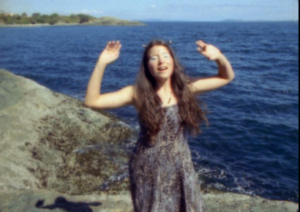
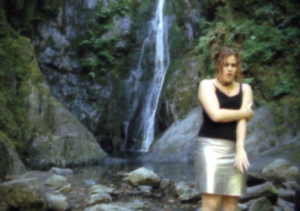
I began the project with an ad because I didn’t know what else to do. At the time I was completely taken with Gillian Wearing’s work and I knew that she used ads, and I thought if she could do it that could be a place to start. It was a different time, the internet wasn’t really a thing then. The ad read: “Female Victoria filmmaker seeks female singer/songwriters ages approximately 17 – 25 to be featured in art film. No experience necessary.” I auditioned many women and selected eight, the women who I thought were compelling. We recorded original songs in a studio and then I filmed them performing along to the recorded tracks. This was in locations around Victoria.
Mike: Can you talk about your collaborative working methods?
Althea: I don’t like the word collaborative as a general category. I think it’s a word like “community” that can be a bit slippery and ought to be avoided unless you are referring to something really specific. As someone who initiates projects, who works as a producer and director, it’s often more interesting to work with other’s ideas in addition to my own. In some cases I already have an idea of what a film might be, and ask people to contribute content, and other times to really develop the idea together. Either way, we make a work together. And are kind of co-authors. Then, I get the main author credit, we could talk about the problems in that. Also, I’m sometimes working in places that do not have a lot of funding, and I am certainly in a position of great privilege. For Songstress I first imagined a film in which several young women sang at the same time. But it became clear that couldn’t happen, the final form needed to be simpler. I knew before we started that we would shoot one hundred foot rolls of 16mm film, and that the performances of the songs would have to be shorter than three minutes because I wanted to film them in a single take with a stationary camera. I knew all that, I don’t know why, I just did. The parameters of shooting without edits and the durational quality came via live performance. Some felt I was retuning musical videos, perhaps because of the lip synching, but I was really thinking about the way performance unfolds in real time.
The songs had to be original, not cover songs, because I wanted them to be specific to each of the women. I knew that I wanted to shoot outside in different locations, and most were chosen by them. I had a formula they had to fit into, and that’s a kind of aggression. They really gave everything that they could, meaning, permission to use their original song, image, and voices.
I didn’t see it right away because it was shot on film and it was a few months before I had money to do the transfer. I remember being taken aback and charmed. They really knocked it out when they sung, what they were doing was a disavowal of my formula.
Mike: Is it a displaced autobiography?
Althea: Kind of, but I saw it as a picture of all of us. All of our making is to some extent… not necessarily autobiographical, but about experiences that stick to us that we continue to rework. I think it’s the case with many artists. I really related to the women at that time in their lives. Their ambitions were similar to hopes I had for my own work. I was just starting the last year of art school, fearless in some ways, and I saw that in them too.
After Songstress came out, some of the young women were criticized. Some people, a few, thought they were foolish and awkward and had bad voices. I thought that was ridiculous and unobservant because all of them were quite amazing. Of course there’s going to be awkward moments when you shoot single takes with performers that aren’t so experienced, that’s part of what you have to negotiate as a viewer. I still think those observations are more a reflection of the people looking than something intrinsic to the women. I was accused of exploiting them, which was hard. I was just starting out and it certainly wasn’t what I intended to do, but it was an important critique for sure. I knew there were moments when it was really uncomfortable to watch, but it never occurred to me that it was exploitative. Slowly, I had to accept that the work was exploitative because there was interest generated from the critique, and I was benefiting from that response. Many were enthusiastic and suggested I do a Songstress in different cities. But that’s exactly what I didn’t want to do. It was a blessing that I was criticized right away because I had to deal with it and figure out what to do. And the criticism didn’t take the form of dismissal because I was accepted in the sense that people seemed to care about what I was doing. There was an opening but also a responsibility. And I got that right away, after I had my first show. Critique, even personal criticism, became normal.
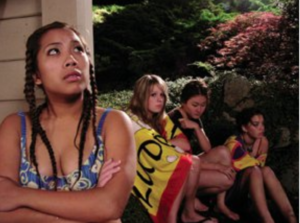
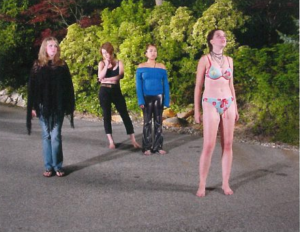
I had a conversation with Emily Vey Duke who was a supporter of my early work. We were both in our early thirties when she said something like, “You know, as I get older, I don’t look at young women with a lot of judgment, I feel love and worry for them.” I realized I had a similar feeling, like an older sister. That’s part of why I was attracted to working with young women then. It’s unfortunate to spend so much time talking about the reaction to Songstress, but it affected the way I thought about working. It took two years to formulate a response and that became A Memory Lasts Forever (31 minutes 2004). Songstress was participatory and co-operative, but I wanted the new work to really be collaborative in generating content. I worked together with four women over a period of three months. We began with an event that happened to me when I was about fifteen. I was with three young friends and we got drunk at a sleep over. The dog went missing and then we found him in the pool. It was chaotic and horrible and we didn’t have the tools to deal with the discovery of the death. They created the details.
At first I thought it would be an operetta with some dialogue because the story is quite operatic. But we didn’t have the resources or skills so it became a musical. We decided that each of the young women would take a turn describing the story the way she wanted, this was the answer to some of the difficulties of Songstress. If I wanted to work with people I had to grant them more of a shared authorship. But I was pretty stuck for a couple of years, I didn’t know what to do.
Mike: Northern (8 minutes 2005) returns you to your tree planting roots. In another single take movie/installation we see a clutch of planters lying as if dead along a clear cut while the camera tracks slowly by. A helicopter arrives and a woman climbs out and revives the first planter she sees, together they wake the next prone figure, and slowly the group moves to resuscitate one after the next. Can you tell me about the movie’s location, the people you worked with, and its theme of waking up to this land.
Althea: The movie’s location is Kananaskis country, it was shot at the tail end of a cut block. Is it OK for me to use tree planter’s language? A cut block can be a large or small portion of land that has been clear cut. After an area’s been cut and logged, according to forestry regulations it needs to be replanted, and that’s the work of tree planters. They go in with little conifer tree seedlings and plant them. It is hard physical labour.
I had planted with this company for ten years, but had never worked in K country. Most of our planting had been in northern Saskatchewan, and northern Alberta, near Slave Lake, the Swan Hills and further north in swampy, flat lands. K country is a large area that’s a little bit east and south of Banff National Park, and had been a provincially protected area for a long time before it was re-designated as a multi-use area by Klein’s Conservatives. Now there’s logging, as well as camping and hunting. The area seems strangely familiar because so many films have been made there like Brokeback Mountain and Unforgiven.
I imagined a scene that looked like it might be a massacre or a war scene or some kind of fairytale. I imagined it as an emotional scene, I first had in mind a woman crying over a traumatic event in the forest, she would encounter people who appeared to be dead or unconscious, though that’s not what we shot in the end. I received my first Canada Council grant, and it seemed like a lot of money but turned out to be not a lot of money to shoot in 35mm and hire a helicopter!
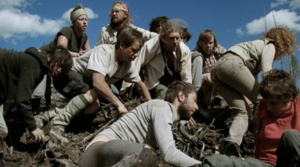
Mike: In an after screening discussion about Northern you said that “there’s a heroism in the single take that undermines the work.” The camera pans over a clutch of supine bodies in a clear cut before a helicopter arrives. A woman gets out and rouses the first person she comes to, and they quickly gather up the rest of the troupe who awaken together. Does squeezing all that action into one shot feel like showing off, is that what you mean?
Althea: Yes, it is a pretty guysy-hero undertaking with a lot of synchronization and luck involved. Structural imperatives are really important to me – using the duration of a single roll of film, and setting up actions that would be contained and framed by that roll. It’s a useful limitation. You impose constraints to have some freedom.
Mike: Making the movie in a single shot turns the shooting into a performance, and perhaps the movie itself is a performance. There’s a deep feeling of solidarity between the people shown, they look like they belong together.
Althea: That’s the thing with tree planters, you start to look the same after living in a tent all summer, working in the bush all day. I’m glad that comes across. It’s funny how buff and handsome they all are. Did you notice that?
Mike: They just looked young, though everyone looks young to me now.
Althea: That happens when you get old. Except when it happens to you its like: oh shit. Not looking young I mean.
Mike: Tree planting seems such a Canadian rite of passage. When I hitched west to give it a whirl a thousand years ago I was struck by the instant community, the raw intensity of the work, the often harsh conditions. I think a third of the crew went down with injuries, and the widespread drugs made the splendor of the mountains that much sharper. It also felt like a refuge for those who didn’t belong anywhere else — the pyromaniacs and socially disordered, the junkies trying to quit and the monosyllabic alcoholics. I’m wondering if you might spin a tale about your time out in the fields.
Althea: You know there’s a wonderful, kind of crazed social scene in the camps. There were certainly wild parties with lots of booze and sometimes crazy makeshift costumes and performing but also a deep comraderie, ethics, and a sense of sharing rites of passage, and there was sleeping around. You do things that you wouldn’t otherwise, but in a suspended way. You’re in this weirdly extreme family and working intimately on the land everyday. The landscapes and bogs and rivers and hillsides, I remember many of them so vividly. Really remote places. Each camp and each contract had its own culture that developed very quickly, and before you knew it, the camp would disappear and there would be a new place. That was how it was for me and the company I worked with anyways, which was a relatively small, family-run contractor. Later, when I became foreman, things were a bit different, of course I became more responsible and wanted my planters to be taken care of.
I’m rambling, what kind of story do you want? I can remember better moments and feelings. Like being alone in the bush late at night spotting trees and the strong feelings of awe and a bit of fear and the beauty of the stars and night and the wildlife that you know are all around you and watching you.
I spent a winter between planting seasons in rural Manitoba in a house that another tree planting friend had bought for next to nothing, southwest of Winnipeg. The house had no heat or plumbing so I had to haul wood and water. In the seventies a hippie commune had moved cabooses into a nearby valley and that area remained a mix of French farmers and hippies. That was long before I went to art school, and I remember meeting Eleanor Bond, who I think was seeing a man from the valley. I was in awe of her. I don’t know if she would even remember me. At the time I was dating a musician who had bought a building in Altamont — a nearby town — for back taxes which he had turned it into a recording studio, and we hosted jam sessions and concerts every week. We would serve homemade booze in order to make money and have incredible parties. That place wasn’t heated either, so we had to bring in makeshift stoves and wood and try to heat the place up before the party. It was all very alcoholic, important and fun. Is this the kind of information you want? I had to learn to get by but also contribute to a local scene any way I could.
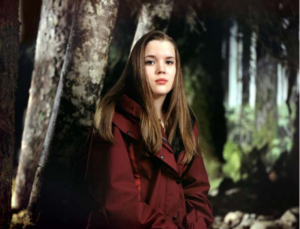

Mike: In not afraid to die (6 minutes 2001) a young woman sits in front of a diorama showing a constructed nature world posed and frozen. The background breathes into the foreground in this single shot (was it important there would be only one?), offering her casual gestures of eating and watching unseen, off-screen events as a kind of posing or construction. Are we only a collection of borrowed gestures, hand-me-down alphabets, and social maneuvers? And perhaps you could spare a few words about the song you dish so beautifully on the soundtrack. It’s all about death, though the girl/woman on view is so very young, and you were so young when you made it. Why all the gloom?
Althea: I was not so young when I made it you know, I was in grad school, I think I was thirty. That was the first film I made that was exhibited. You are right, it is shot in the diorama of the Royal B.C. Museum in Victoria that is a representation of the local rain forest. I got permission to shoot right after they closed the exhibition to the public, and just before they turned on the alarms, so we had to be pretty quick. This was another film that I had an emotional image in mind before making it. The image was again of someone crying. That is not what happened in the film however. In the film the girl takes a snack out of her snack pack and eats it pretty quickly. There is a shift in the film from the moments where she is just looking around, being observed by the camera, and rather self-conscious, and then when she is eating. In a crude way, I understood it as a shift in power relations. She shifts from object-hood to subject-hood, and that shift is enabled through consumption. I think it’s gloomy, but others find it hilarious, perhaps it depends on your mood. Why was it shot in a single take? At the time, I was working primarily in photography, and I was thinking about the possibilities of film as a kind of still image, or a still framed image that had movement and duration. The work is really a portrait, and I wanted it to be considered in terms of the traditional and formal language of portraiture and landscape (and relation to the land), to which we bring considerations of class and race and gender and gaze. In this case, the subject of the portrait is more or less immobilized, but also demonstrated some agency and maybe surprises us. The Gore-Tex jacket she wears was a very important signifier. I chose it carefully in terms of branding and colour. That was fun, but also stressful because it was expensive and I had to return it to the shop after the shoot. Are we only a collection as you say? No. But so many of our expressions are learned and repeated. So many of us are frozen in habit and immobilized and this is disastrous. Are we only a collection of borrowed gestures? No, we’re not only that, but it’s a big part of what we are, and it’s worsening because the imaginations available to us are narrow. I guess I am talking about the political imagination in relation to what we must do, to resist destruction, but also in terms of what we might be. As subjects, actors, thinkers. How we can think and experience, and affect change? Our attention is becoming more focused and distracted, because the accepted vocabularies are less and less open in comparison to the expanding vocabularies of power and production.